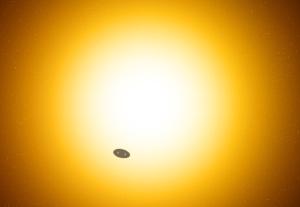Blog
Ring World
2 March 2020
 Robin Dienel/Carnegie Institution for Science
Robin Dienel/Carnegie Institution for ScienceRecently some exoplanets were discovered that appear to have unusually low densities. Terrestrial planets such as Earth have densities around 4 - 5 g/cc, and even gas planets such as Saturn have densities around 1 g/cc. But these strange worlds seem to have densities less than 0.1 g/cc. They have been called super-puff planets.
It’s difficult to imagine how a planet could maintain such a low density. Perhaps they have thick atmospheres that have swollen to an unusual size. Or perhaps they are worlds still in the process of forming. But another possibility is that they aren’t really low-density worlds after all. Perhaps they have large ring systems that make them appear larger than they are.
Most of the exoplanets we have discovered haven’t been observed directly. We know they are there because they block their star slightly when they pass in front of it (transit) making the star appear slightly dimmer. Or we observe their gravitational tug on the star, which makes the star wobble slightly. Everything we learn about an exoplanet is from these optical and gravitational effects.
To measure the density of a world, we need to know two things: its mass, and its size. From the wobble of the star, we can measure an exoplanet’s mass, since the gravitational pull of a planet is proportional to its mass. The size of a planet can be determined by watching the star dim. The larger the planet, the more starlight it blocks while transiting.
Most of the exoplanets we’ve discovered by the transit method. We know how large they are, but can only guess their mass by comparing them to other planets. When super-puff planets transit their star, they look like large gas planets. There are lots of known Jupiter-type exoplanets, so this isn’t unusual. But when these worlds are observed by the radial method, their mass is much lower than expected.
The masses of these worlds is probably correct. The radial method of exoplanet measurement is difficult to get wrong. But a new study suggests these super-puff worlds appear much larger than they are because they have large ring systems.1
Most gas planets have some type of ring system, but worlds such as Saturn have a large opaque ring system. If the rings block starlight as well as the planet, astronomers might overestimate the planet’s size and underestimate its density. For example, if an alien civilization measured Saturn’s size by observing it transit the Sun, they might assume Saturn’s density is half of what it really is.
If these super-puff worlds have densities similar to other gas planets, then their ring systems would need to be even larger and more grand than those of Saturn. But this could be possible, particularly if the planets rotate rapidly.
The team simulated the transits of various ringed planets and compared them to the observed transits of super-puff exoplanets. They found that rings could account for at least some of the worlds. The model is particularly well suited for two super-puff planets, Kepler 87c and Kepler 177c. Other worlds don’t fit the model very well, so it is possible that rings explain many low-density worlds, but not all of them.
With more detailed observations, this model could be tested. By measuring the spectrum of starlight as a planet transits, astronomers could distinguish rocky or icy material of the rings from the gaseous atmosphere of the planet itself. Then we would know whether they are truly super puffy, or simply showing off their planetary bling.
Piro, Anthony L., and Shreyas Vissapragada. “Exploring Whether Super-Puffs Can Be Explained as Ringed Exoplanets.” The Astronomical Journal, Volume 159, Number 4 (2019). ↩︎